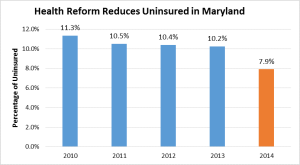More People in Maryland Have Insurance Thanks to Health Care Reform
The total number of Maryland residents who now have health coverage has increased substantially as a direct result of federal health care reform and Maryland’s expansion of Medicaid, which has helped to improve the state’s economy and made it a better place to live.
Since the implementation of the Affordable Care Act, the share of Marylanders without health coverage has fallen significantly. The uninsured rate fell from a peak of 11.3 percent in 2010 to 7.9 percent in 2014, according to the Census Bureau’s latest official data on health insurance rates, released today. In total, 177,861 more Marylanders have health insurance than in 2010, which means they no longer have to worry about how they will get the health care they need to be able to go to work, care for their kids and be productive members of their communities.

As part of health care reform, Maryland created a health insurance exchange, the Maryland Health Connection, and strengthened Medicaid by extending eligibility to more people and making it easier for people to enroll. These features made it significantly easier for residents to obtain either private or public health insurance. The Maryland Health Connection also made the federal subsidies that help people with low incomes purchase health plans more accessible to Marylanders.
States that expanded Medicaid – like Maryland – to include more people had a higher share of people with insurance than states that did not expand Medicaid, and that gap is growing.
By creating a pathway for more Maryland residents to become insured, health care reform has provided opportunities for these people to thrive. Individuals who do not have insurance are less likely to seek medical care when they need it and, as a result, can develop or worsen serious health problems, which can make it difficult for them to work and take care of their family. Uninsured Americans receive about half as much health care as those with coverage, even after controlling for age, income, health status, and the availability of free care. And, the lack of insurance also is a financial burden for uninsured individuals and families, leaving some to face medical bills they can’t afford to pay.
Because of health care reform, Maryland has benefited from having more of its population insured without absorbing additional costs. The federal government is covering all the costs of expansion through the end of 2016, and will cover at least 90 percent after that. In states like Maryland that have expanded Medicaid, hospitals are treating fewer uninsured patients who can’t afford to pay their medical bills out of pocket, and as a result, states are saving money since they don’t have to pick up these costs for hospitals. Additionally, the growth in private and public insurance coverage also has created thousands of new jobs in health-related fields while improving the wellbeing of many men women and children in Maryland.
Maryland has shown that investing in the health of residents benefits the state on multiple levels. However, the progress made as a result of health care reform is now threatened by the Governor’s across the board cuts, which will hurt important services that Marylanders rely on every day, including health care. Legislators should continue to vigorously oppose such cuts, as the gains from health care reform illustrate the benefits of investment in the state’s future.
